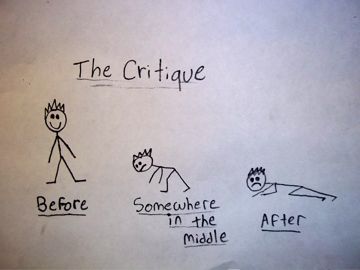Like many art students, I couldn’t stand critiques when I was in high school and especially college. I even had a professor in grad school that would survey the finished work silently while we waited what seemed like days for those first syllables of sophistication to leave his crummy lips. And each time, right before he spoke, he would abruptly pull out the pushpins on five or six works that didn’t meet his approval. More than once I saw my drawing gently fall to the floor like a leaf. Hours of work sitting in the middle of eraser shavings while the class discussion took place as if nothing was wrong with this scenario.
Now I absolutely realize that most critiques are not this horrific and that many, many teachers from coast to coast do not conduct business this way. But still, I wonder about the purpose of critiques at the “end” of assignments, projects, or units of study. I mean, as an art student, I rarely if ever went back to a “finished” work and improved it after a class critique. As a matter of fact I can only remember doing it once and it was primarily to get a better grade, not because I thought the composition really needed that extra banana.
Often, students are “done” (in more ways than one) with a given assignment before the final critique rolls in, and what we’re left with is usually an opportunity for a teacher (or students) to pontificate or for a class to try in every way possible to say things that won’t hurt someone’s feelings…. and yet somehow be constructive- not an easy task.
I propose we think long and hard about planning less critiques that take place at the end of assignments and more that take place in the middle of them. In-progress critiques allow for constructive criticism and suggestions right when students need it the most- when they have formed an idea and are in the midst of giving that idea form. Students get to ask questions of each other instead of being judged and often receive suggestions from classmates that I would never have come up with myself.
Next week I would like to introduce some specific strategies for setting up in-progress critiques. See you then. Don’t touch that dial.





Pingback: Rethinking “The Critique” : Possibilities | Art21 Blog
Pingback: New style of Critique | bethany mallick